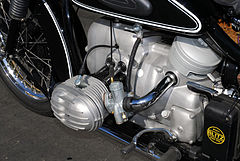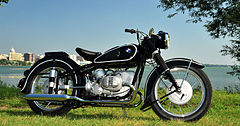BMW R 51/3
The BMW R 51/3 is a sidecar-compatible two-cylinder motorcycle from the manufacturer BMW with a displacement of 500 cm³ , a boxer engine with 18 kW (24 hp) and cardan drive, which was produced in 18,420 units from 1951 to 1954 . The sales price was DM 2,750. Together with the BMW R 67 , which was released at the same time, it was the first major new BMW motorcycle development after the Second World War, following the BMW R 51 (1938–1940) and the R 51/2 , which had only been produced in 1950 .
Design features
The double loop frame is welded from tubular steel and has ball heads on the side to accommodate a sidecar. Matching sidecars are the S 350, better still the TR 500 from Steib . A modified (shorter) gear ratio of the cardan drive is required for sidecar operation.
The mudguards and tank are made of sheet steel, the engine block, the gearbox and the cardan gearbox are made of cast aluminum . As with the previous models BMW R 51/2 and BMW R 51, the engine is mounted with two quick-release axles in rubber bushings on the frame. The “fishtail” mufflers were attached directly to the engine axle and frame with clamps. In 1954 they were replaced by a modern shape.
engine
The engine of the R 51/3 has been completely redeveloped compared to its predecessor of the same power, the R 51/2, with only one gear-driven camshaft above the crankshaft ; the previous engine, the BMW R 51/2, had two camshafts that were driven by a chain.
As in the previous models, the BMW R 51 and BMW R 51/2, the engine is a longitudinally installed two-cylinder boxer four-stroke engine with bumpers ( OHV ) running above the cylinders in protective tubes made of chrome-plated steel . These push rods actuate the rocker arms in the cylinder heads, which in turn actuate the overhead valves. The rocker arm, piston pin and connecting rod are mounted in bronze bushes; the crankshaft runs in ball bearings. The gear - the oil pump is located behind the front housing cover and is spur gears driven.
transmission
On the rear crankshaft stub is the heavy flywheel (with ignition timing mark) that holds the dry single-disc clutch . The clutch is operated with a thrust bearing via a push rod that runs through the hollow main shaft of the 4-speed gearbox. This model has the classic curved chrome-plated starter lever. On the left there is a footshift lever and on the right a handshift lever in accordance with the then standard DIN 73005 (May 1940 edition), which (until March 1970) required: “Footshift is mandatory for all motorcycles. In addition, a manual gearshift lever must be available to operate the gearshift under special conditions on motorcycles with a displacement of 250 cm³ and above ”.
Ignition and alternator
The Noris DC alternator with charge regulator is located on the front crankshaft stub behind the housing cover . The ignition system is not a battery ignition, but a magneto with centrifugal adjustment and is driven by the camshaft. The motorcycle can therefore still drive with an empty battery (or without it), since the ignition current is generated independently of the battery. The lead accumulator is attached to a holder under the saddle without being encapsulated.
Carburetor, air filter
The carburetors are Bing float chamber carburetors with a conical needle in the round slide and a 22 mm passage cross-section. The wet air filter element sits on the gear housing, a steel mesh on which the dust clings when the air is sucked in and which is washed out and moistened with oil during maintenance.
drive
The drive train has an elastic torque transmission element, a textile-reinforced rubber four-hole disk ( Hardy disk ) , at the transmission output . It is pushed onto the two-finger flange of the gearbox and transfers the torque from the gearbox output shaft to the two-finger mount on the cardan shaft . Due to the high centrifugal forces of the rotating rubber disc, the hardy disc has a chrome-plated steel ring on the circumference.
The high-gloss chrome-plated cardan shaft is not encapsulated. The universal joint of the cardan shaft attached to the bevel gear is covered with a chrome-plated screw cap to protect it from dust. A rubber seal that rotates with the shaft and keeps dirt away from the universal joint runs against this screw cap.
The bevel gear with 90 ° deflection on the rear axle is filled with heavy gear oil for high flank pressures (hypoid oil).
bikes
In 1954, the two-tone painted steel rims (3 × 19) were replaced by light alloy rims and the steel half-hub brakes ("can cover brakes") were replaced by wide aluminum full brake hubs, after the front brake had already been improved in 1952 with the aid of a duplex version. The brake drum diameter remained unchanged at 200 mm, as did the tire size 3.50-19.
Technical specifications
| Parameter | Data of the R 51/3 | |
|---|---|---|
| design type | Two-cylinder boxer with cardan | |
| engine | Four-stroke OHV | |
| construction time | 1951-1954 | |
| drilling | 68 mm | |
| Hub | 68 mm | |
| Displacement | 494 cc | |
| Power (kW / PS) | 18/24 at 5,800 min -1 | |
| Top speed | 135 km / h | |
| Empty weight | 190 kg | |
- Front brake type Duplex from 1952
- Rear brake design Simplex
- greatest width 790 mm
- greatest length 2130 mm
- Saddle height 725 mm
- Ground clearance 103 mm
- Wheelbase 1400 mm
- permissible total weight solo 355 kg
- permissible total weight of the combination 600 kg
- Empty weight with orig. BMW sidecar 320 kg
See also
Web links
- BMW R 51/3. In: BMW history. BMW AG, accessed on June 19, 2016 (dossier of the BMW Group Archives).
- Spare parts list for BMW motorcycles R 51/3, R 67, R 67/2. May 1952 edition. In: BMW History. BMW AG, May 1954, accessed on June 19, 2016 (spare parts list with pictures, 32 pages).
Individual evidence
- ↑ Price list no. 2/1951. In: BMW history. BMW AG, October 1951, accessed on June 19, 2016 (document in the BMW Group Archive).
- ^ Manual BMW Motorrad R 51/3 R 67. In: BMW History. BMW AG, December 1951, accessed on June 19, 2016 (manual with pictures, 85 pages).


